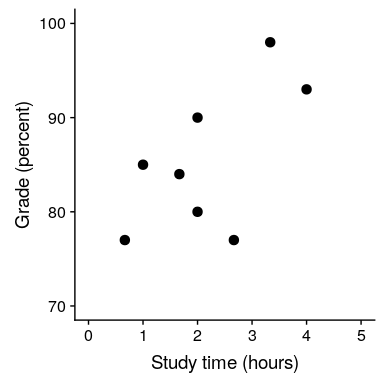# 14 一般線性模型
請記住,在本書的早期,我們描述了統計的基本模型:

其中,我們的一般目標是找到最大限度地減少錯誤的模型,并受一些其他約束(例如保持模型相對簡單,以便我們可以在特定數據集之外進行歸納)。在本章中,我們將重點介紹這種方法的特殊實現,即 _ 一般線性模型 _(或 GLM)。您已經在前面一章中看到了將模型擬合到數據的一般線性模型,我們在 nhanes 數據集中將高度建模為年齡的函數;在這里,我們將更全面地介紹 GLM 的概念及其許多用途。
在討論一般線性模型之前,我們先定義兩個對我們的討論很重要的術語:
* _ 因變量 _:這是我們的模型要解釋的結果變量(通常稱為 _y_)
* _ 自變量 _:這是一個我們希望用來解釋因變量的變量(通常稱為 _x_)。
可能有多個自變量,但對于本課程,我們的分析中只有一個因變量。
一般線性模型是由獨立變量的 _ 線性組合 _ 組成的,每個獨立變量乘以一個權重(通常稱為希臘字母 beta-),確定相對貢獻。模型預測的自變量。
作為一個例子,讓我們為學習時間和考試成績之間的關系生成一些模擬數據(參見圖[14.1](#fig:StudytimeGrades))。
```r
# create simulated data for example
set.seed(12345)
# the number of points that having a prior class increases grades
betas <- c(6, 5)
df <-
tibble(
studyTime = c(2, 3, 5, 6, 6, 8, 10, 12) / 3,
priorClass = c(0, 1, 1, 0, 1, 0, 1, 0)
) %>%
mutate(
grade =
studyTime * betas[1] +
priorClass * betas[2] +
round(rnorm(8, mean = 70, sd = 5))
)
```

圖 14.1 學習時間與成績的關系
鑒于這些數據,我們可能希望參與三項基本統計活動:
* _ 描述一下 _:年級和學習時間之間的關系有多強?
* _ 決定 _:年級和學習時間之間有統計學意義的關系嗎?
* _ 預測 _:給定特定的學習時間,我們期望達到什么級別?
在最后一章中,我們學習了如何使用相關系數來描述兩個變量之間的關系,因此我們可以使用它來描述這里的關系,并測試相關性是否具有統計意義:
```r
# compute correlation between grades and study time
corTestResult <- cor.test(df$grade, df$studyTime, alternative = "greater")
corTestResult
```
```r
##
## Pearson's product-moment correlation
##
## data: df$grade and df$studyTime
## t = 2, df = 6, p-value = 0.05
## alternative hypothesis: true correlation is greater than 0
## 95 percent confidence interval:
## 0.014 1.000
## sample estimates:
## cor
## 0.63
```
相關性很高,但由于樣本量很小,幾乎沒有達到統計顯著性。
- 前言
- 0.1 本書為什么存在?
- 0.2 你不是統計學家-我們為什么要聽你的?
- 0.3 為什么是 R?
- 0.4 數據的黃金時代
- 0.5 開源書籍
- 0.6 確認
- 1 引言
- 1.1 什么是統計思維?
- 1.2 統計數據能為我們做什么?
- 1.3 統計學的基本概念
- 1.4 因果關系與統計
- 1.5 閱讀建議
- 2 處理數據
- 2.1 什么是數據?
- 2.2 測量尺度
- 2.3 什么是良好的測量?
- 2.4 閱讀建議
- 3 概率
- 3.1 什么是概率?
- 3.2 我們如何確定概率?
- 3.3 概率分布
- 3.4 條件概率
- 3.5 根據數據計算條件概率
- 3.6 獨立性
- 3.7 逆轉條件概率:貝葉斯規則
- 3.8 數據學習
- 3.9 優勢比
- 3.10 概率是什么意思?
- 3.11 閱讀建議
- 4 匯總數據
- 4.1 為什么要總結數據?
- 4.2 使用表格匯總數據
- 4.3 分布的理想化表示
- 4.4 閱讀建議
- 5 將模型擬合到數據
- 5.1 什么是模型?
- 5.2 統計建模:示例
- 5.3 什么使模型“良好”?
- 5.4 模型是否太好?
- 5.5 最簡單的模型:平均值
- 5.6 模式
- 5.7 變異性:平均值與數據的擬合程度如何?
- 5.8 使用模擬了解統計數據
- 5.9 Z 分數
- 6 數據可視化
- 6.1 數據可視化如何拯救生命
- 6.2 繪圖解剖
- 6.3 使用 ggplot 在 R 中繪制
- 6.4 良好可視化原則
- 6.5 最大化數據/墨水比
- 6.6 避免圖表垃圾
- 6.7 避免數據失真
- 6.8 謊言因素
- 6.9 記住人的局限性
- 6.10 其他因素的修正
- 6.11 建議閱讀和視頻
- 7 取樣
- 7.1 我們如何取樣?
- 7.2 采樣誤差
- 7.3 平均值的標準誤差
- 7.4 中心極限定理
- 7.5 置信區間
- 7.6 閱讀建議
- 8 重新采樣和模擬
- 8.1 蒙特卡羅模擬
- 8.2 統計的隨機性
- 8.3 生成隨機數
- 8.4 使用蒙特卡羅模擬
- 8.5 使用模擬統計:引導程序
- 8.6 閱讀建議
- 9 假設檢驗
- 9.1 無效假設統計檢驗(NHST)
- 9.2 無效假設統計檢驗:一個例子
- 9.3 無效假設檢驗過程
- 9.4 現代環境下的 NHST:多重測試
- 9.5 閱讀建議
- 10 置信區間、效應大小和統計功率
- 10.1 置信區間
- 10.2 效果大小
- 10.3 統計能力
- 10.4 閱讀建議
- 11 貝葉斯統計
- 11.1 生成模型
- 11.2 貝葉斯定理與逆推理
- 11.3 進行貝葉斯估計
- 11.4 估計后驗分布
- 11.5 選擇優先權
- 11.6 貝葉斯假設檢驗
- 11.7 閱讀建議
- 12 分類關系建模
- 12.1 示例:糖果顏色
- 12.2 皮爾遜卡方檢驗
- 12.3 應急表及雙向試驗
- 12.4 標準化殘差
- 12.5 優勢比
- 12.6 貝葉斯系數
- 12.7 超出 2 x 2 表的分類分析
- 12.8 注意辛普森悖論
- 13 建模持續關系
- 13.1 一個例子:仇恨犯罪和收入不平等
- 13.2 收入不平等是否與仇恨犯罪有關?
- 13.3 協方差和相關性
- 13.4 相關性和因果關系
- 13.5 閱讀建議
- 14 一般線性模型
- 14.1 線性回歸
- 14.2 安裝更復雜的模型
- 14.3 變量之間的相互作用
- 14.4“預測”的真正含義是什么?
- 14.5 閱讀建議
- 15 比較方法
- 15.1 學生 T 考試
- 15.2 t 檢驗作為線性模型
- 15.3 平均差的貝葉斯因子
- 15.4 配對 t 檢驗
- 15.5 比較兩種以上的方法
- 16 統計建模過程:一個實例
- 16.1 統計建模過程
- 17 做重復性研究
- 17.1 我們認為科學應該如何運作
- 17.2 科學(有時)是如何工作的
- 17.3 科學中的再現性危機
- 17.4 有問題的研究實踐
- 17.5 進行重復性研究
- 17.6 進行重復性數據分析
- 17.7 結論:提高科學水平
- 17.8 閱讀建議
- References
